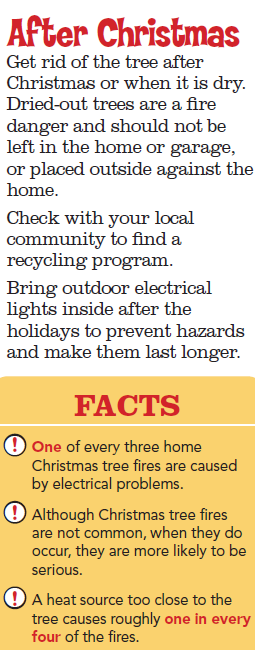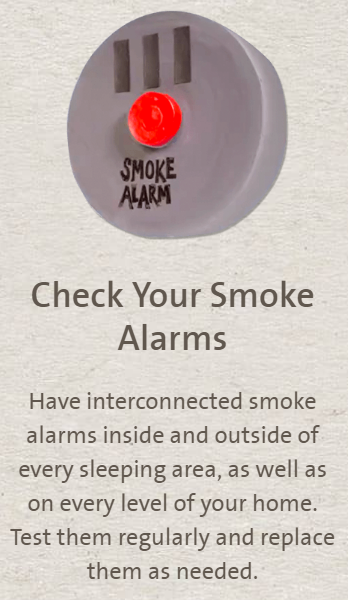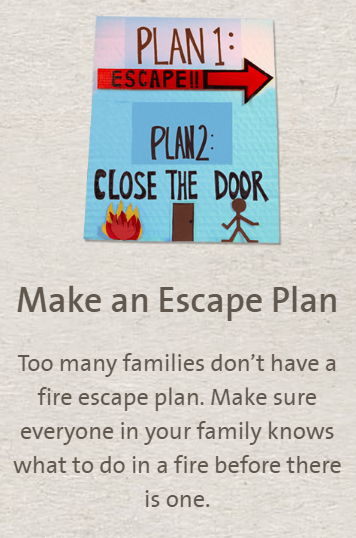



Fire is getting faster, but you can get ahead of it!



Everyone should carry a Winter Survival Kit in their car. In an emergency, it could save your life and the lives of your passengers. Here is what you need:
|
Kit tips:
911 tips:
Survival tips:

With more than 500,000 ladder-related injuries and more than 42,000 medically-treated raking-related injuries each year, it’s important to focus on safety when cleaning up outside to prepare for winter, according to the US Consumer Product Safety Commission![]() (CPSC).
(CPSC).
The American Academy of Orthopaedic Surgeons![]() (AAOS) recommends following these ladder safety tips to prevent injuries:
(AAOS) recommends following these ladder safety tips to prevent injuries:
The AAOS also recommends additional safety measures for safe fall cleanup:
Even if a chore seems simple, it can cause an injury if you’re not prepared. Take your time and be ready before jumping into your fall chore list.
Our lives can be complicated enough, but with all the other urgent concerns going on currently – hurricanes, wildfires, nuclear weapons testing, as well as the day-to-day stresses, the following information may prove very helpful to you or your loved ones.
While the post below is from the American Psychological Association and makes reference to psychologists as a helpful resource, there are many types of assistance available including our own Employee Assistance Program.
https://www.butler.edu/hr/benefits/health-wellness/employee-assistance-program
One of the most common signs of emotional crisis is a clear and abrupt change in behavior. Some examples include:
Sometimes, these changes happen suddenly and obviously. Events such as a natural disaster or the loss of a job can bring on a crisis in a short period of time. Often, though, behavior changes come about gradually. If something doesn’t seem right with your loved one, think back over the past few weeks or months to consider signs of change.
Don’t wait to bring up your concerns. It’s always better to intervene early, before your loved one’s emotional distress becomes an emergency situation. If you have a feeling that something is wrong, you’re probably right.

If you suspect your loved one is experiencing a mental health crisis, reaching out is the first step to providing the help he or she needs to get better. Sit down to talk in a supportive, non-judgmental way. You might start the conversation with a casual invitation: “Let’s talk. You don’t seem like yourself lately. Is there something going on?”
Stay calm, and do more listening than talking. Show your loved one that you can be trusted to lend an ear and give support without passing judgment. When discussing your concerns, stick to the facts and try not to blame or criticize.
Reaching out can help your friend or family member begin to get a handle on an emotional crisis. But professional help is the best way to fully address a mental health problem and get that problem under control. You can explain that psychologists have specialized training that makes them experts in understanding and treating complex emotional and behavioral problems. That training is especially critical when an emotional disorder has reached crisis levels.
Psychologists use scientifically tested techniques that go beyond talking and listening. They can teach their clients tools and skills for dealing with problems, managing stress and working toward goals.
To help your loved one find a psychologist to speak with, you might encourage your loved one to speak to his or her primary care provider about available mental health resources in your community. If your workplace has an employee assistance program (EAP), that can be a useful resource and referral service. You can also find a psychologist in your area by using APA’s Psychologist Locator Service.
No emotional crisis is more urgent than suicidal thoughts and behavior, or threats to harm someone else. If you suspect a loved one is considering self-harm or suicide, don’t wait to intervene.
It’s a difficult topic to bring up, but discussing suicide will not put the idea in someone’s head. In fact, it’s not abnormal for a person to have briefly thought about suicide. It becomes abnormal when someone starts to see suicide as the only solution to his or her problems.
If you discover or suspect that your loved one is dwelling on thoughts of self-harm, or developing a plan, it’s an emergency. If possible, take him or her to the emergency room for urgent attention. Medical staff in the ER can help you deal with the crisis and keep your loved one safe.
If you think someone is suicidal or will harm someone else, do not leave him or her alone. If he or she will not seek help or call 911, eliminate access to firearms or other potential tools for harm to self or others, including unsupervised access to medications.
The National Suicide Prevention Lifeline is also a valuable resource. If you’re concerned about a loved one’s mental state or personal safety, and unable to take him or her to the emergency room, you can talk to a skilled counselor by calling 1-800-273-TALK.
If you’re concerned about a loved one, don’t put it off. You can make the difference in helping your friend or family member get back on track to good mental health.

Experiencing bullying is challenging and upsetting. It’s one of those situations that may negatively impact a person’s mental health and can alter the path a person takes, depending on how the situation is handled.
As more of life has become digital and online, bullies have gone there too. The problem with online bullies is that they are faceless and often harder to identify and stop than bullies who are off-line. The negative effect, though, is no less significant, on children and adolescents. In fact, online bullying—cyberbullying—is the most common negative situation that can happen while spending time in the online space to any of our kids.
Kids do not report it to adults and do not want to rat out their friends. To add insult to injury, schools may not always have great strategies for handling it.
It can be challenging to figure out. Look for subtle signs or changes in behavior:
Kids who bully may have similar signs, but you may notice unusual computer activity such as switching screens when you walk in or multiple log-ins that you do not recognize.
As with all childhood changes from usual behavior, anything that is extreme and interfering with home, school, and friends warrants further review. Call the school to see if grades are slipping, and call your pediatrician to arrange an evaluation including a discussion of whether it would be appropriate to obtain psychologic input.
Bullying is on the rise due to technologic changes in our culture. The ease of access coupled with technology is part of the issue. The indirect nature of the Internet allows kids to be mean, because of the faceless power that the screen builds in. Being online also removes the empathy that face-to face contact creates.
Ross Ellis, founder and CEO, Love Our Children USA, a national nonprofit dedicated to stopping all violence against children, including bullying, agrees: “Cyberbullying is huge.” E-mails and calls she receives from families confirm the statistics, and she has learned about cyberbullying by instant message (IM), e-mail, and texting. Her best advice to parents is to take all threats any child tells them about seriously: “You don’t know the hatred of the bully.” She is so right about that. It is very important to evaluate all threats a child informs you of to determine the level of intensity and how much danger your child may be in.
Call the police if the situation seems to place your child in serious danger with a significant threat, or the other parent will not help you.
Studies show that the child being bullied often knows the bully. The police can track the IP address to find the bully and keep your child safe, which is the ultimate goal. Even if your child claims to know the bully, knowing for sure by tracking the IP is the best insurance policy, as there have been cases of mistaken identity in the online world with people using other people’s computers and cell phones to send harmful messages and bully.
“If a child says he or she was bullied, take it seriously,” Ross told me. “That’s a form of violence against a child. It must be taken seriously and the child needs help and tools to figure out how to be safe and prevent them from being hurt physically and emotionally. . Adults must listen.”
Any child spending time online is at risk for being bullied. Our off-line senses for detecting that something is off with our child will help us pick up that something may have occurred and questions should be asked. And you may want to consider using special software monitoring programs that help you uncover situations that your child may not know how to talk to you about to help make conversations that kids find very difficult more easy to bring up to any adult, including parents.
It’s important to keep an open mind and listen without overreacting if your child comes to you with hard-to-hear information. And be on the lookout.
The AAP has an Internet Safety site that provides resources from the AAP and other organizations to help kids, teens and families use websites and social media safely. In addition to recommendations from pediatricians, the SafetyNet site has a Family Media Use Form, and links to external sites including On Guard Online (an comprehensive guide to being smart and safe online) and NetSmartz (an interactive, educational safety resource). Click here to visit SafeyNet.
https://www.healthychildren.org/English/family-life/Media/Pages/Cyberbullying.aspx
Consumer Reports just released their annual list of top sunscreens, with a few important reminders. The number on the bottle isn’t always accurate: Of the 58 lotions, sprays and sticks rated by Consumer Reports this year, 20 of them tested at less than half of the SPF listed on their label. For example, one sunscreen they tested was labeled SPF 30, but the UVB protection it actually provided was between 10 and 19.
There were some winners, though. Here are their top five sunscreens:

If you can’t find one of the products listed above, Consumer Reports recommends using a sunscreen with an SPF of at least 40. It should also contain ingredients like avobenzone rather than “natural” ingredients.
Looking for a sunscreen you can spray? Trader Joe’s Spray SPF 50+ received an excellent rating, along with Banana Boat SunComfort Clear UltraMist Spray and Equate Sport Continuous Spray SPF 30. Though there are a few things to keep in mind when using a sunscreen spray.
“You have to hold the nozzle close to your skin, and don’t spray the product into the wind. You often see parents running behind kids on the beach, spraying. That’s not an effective way to apply sunscreen,” Joshua Zeichner, M.D., director of cosmetic and clinical research in the dermatology department at Mount Sinai Hospital in New York City said, in the report.
You should also rub the sunscreen in after you spray it on — which some people don’t do.
Regardless of what kind of sunscreen you choose, follow these steps to avoid getting burnt:
Remember to apply sunscreen to often-forgotten parts of your body like your scalp, toes, ears and more. Wear a hat when you can!
For more information, check out the full story on Consumer Reports.
http://www.today.com/health/consumer-reports-reveals-best-sunscreens-buy-2017-t111677
Myth: If you’re caught outside  during a thunderstorm, you should crouch down to reduce your risk of being struck.
during a thunderstorm, you should crouch down to reduce your risk of being struck.
Fact: Crouching doesn’t make you any safer outdoors. Run to a substantial building or hard topped vehicle. If you are too far to run to one of these options, you have no good alternative. You are NOT safe anywhere outdoors.
See our safety page for tips that may slightly reduce your risk.
Myth: Lightning never strikes the same place twice.
Fact: Lightning often strikes the same place repeatedly, especially if it’s a tall, pointy, isolated object. The Empire State Building is hit an average of 23 times a year
Myth: If it’s not raining or there aren’t clouds overhead, you’re safe from lightning.
Fact: Lightning often strikes more than three miles from the center of the thunderstorm, far outside the rain or thunderstorm cloud. “Bolts from the blue” can strike 10-15 miles from the thunderstorm.
Myth: Rubber tires on a car protect you from lightning by insulating you from the ground.
Fact: Most cars are safe from lightning, but it is the metal roof and metal sides that protect you, NOT the rubber tires. Remember, convertibles, motorcycles, bicycles, open-shelled outdoor recreational vehicles and cars with fiberglass shells offer no protection from lightning. When lightning strikes a vehicle, it goes through the metal frame into the ground. Don’t lean on doors during a thunderstorm.
Myth: A lightning victim is electrified. If you touch them, you’ll be electrocuted.
Fact: The human body does not store electricity. It is perfectly safe to touch a lightning victim to give them first aid. This is the most chilling of lightning Myths. Imagine if someone died because people were afraid to give CPR!
Myth: If outside in a thunderstorm, you should seek shelter under a tree to stay dry.
Fact: Being underneath a tree is the second leading cause of lightning casualties. Better to get wet than fried!
Myth: If you are in a house, you are 100% safe from lightning.
Fact: A house is a safe place to be during a thunderstorm as long as you avoid anything that conducts electricity. This means staying off corded phones, electrical appliances, wires, TV cables, computers, plumbing, metal doors and windows. Windows are hazardous for two reasons: wind generated during a thunderstorm can blow objects into the window, breaking it and causing glass to shatter and second, in older homes, in rare instances, lightning can come in cracks in the sides of windows.
Myth: If thunderstorms threaten while you are outside playing a game, it is okay to finish it before seeking shelter.
Fact: Many lightning casualties occur because people do not seek shelter soon enough. No game is worth death or life-long injuries. Seek proper shelter immediately if you hear thunder. Adults are responsible for the safety of children.
Myth: Structures with metal, or metal on the body (jewelry, cell phones,Mp3 players, watches, etc), attract lightning.
Fact: Height, pointy shape, and isolation are the dominant factors controlling where a lightning bolt will strike. The presence of metal makes absolutely no difference on where lightning strikes. Mountains are made of stone but get struck by lightning many times a year. When lightning threatens, take proper protective action immediately by seeking a safe shelter – don’t waste time removing metal. While metal does not attract lightning, it does conduct it so stay away from metal fences, railing, bleachers, etc.
Myth: If trapped outside and lightning is about to strike, I should lie flat on the ground.
Fact: Lying flat increases your chance of being affected by potentially deadly ground current. If you are caught outside in a thunderstorm, you keep moving toward a safe shelter.
Myth: lightning flashes are 3-4 km apart
Fact: Old data said successive flashes were on the order of 3-4 km apart. New data shows half the flashes are about 9 km apart. The National Severe Storms Laboratory report concludes: “It appears the safety rules need to be modified to increase the distance from a previous flash which can be considered to be relatively safe, to at least 10 to 13 km (6 to 8 miles). In the past, 3 to 5 km (2-3 miles) was as used in lightning safety education.” Source: Separation Between Successive Lightning Flashes in Different Storms Systems: 1998, Lopez & Holle, from Proceedings 1998 Intl Lightning Detection Conference, Tucson AZ, November 1998.
Myth: A High Percentage of Lightning Flashes Are Forked.
Fact: Many cloud-to-ground lightning flashes have forked or multiple attachment points to earth. Tests carried out in the US and Japan verify this finding in at least half of negative flashes and more than 70% of positive flashes. Many lightning detectors cannot acquire accurate information about these multiple ground lightning attachments. Source: Termination of Multiple Stroke Flashes Observed by Electro- Magnetic Field: 1998, Ishii, et al. Proceedings 1998 Int’l Lightning Protection Conference, Birmingham UK, Sept. 1998.
Myth: Lightning Can Spread out Some 60 Feet After Striking Earth.
Fact: Radial horizontal arcing has been measured at least 20 m. from the point where lightning hits ground. Depending on soils characteristics, safe conditions for people and equipment near lightning termination points (ground rods) may need to be re-evaluated. Source: 1993 Triggered Lightning Test Program: Environments Within 20 meters of the Lightning Channel and Small Are Temporary Protection Concepts: 1993, SAND94-0311, Sandia Natl Lab, Albuquerque NM.